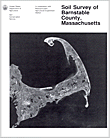The following is a map unit description from the "Soil Survey of Barnstable County, Massachusetts (Fletcher, 1993)"

ImA-Ipswich, Pawcatuck, and Matunuck peats, 0 to 1 percent slopes. These very deep, level, very poorly drained soils are in tidal areas that are subject to daily inundation by salt water. They are adjacent to shore areas and brackish ponds. They make up about 5.6 percent (14,176 acres) of the survey area. Areas are irregular in shape and range from 5 to 2,500 acres in size. They consist of Ipswich soil, Pawcatuck soil, Matunuck soil, or a combination of these. The total acreage is about 60 percent Ipswich soil, 25 percent Pawcatuck soil, 10 percent Matunuck soil, and 5 percent other soils. The soils are mapped together because no major differences affect their use and management.
Typically, the surface layer of the Ipswich soil is dark grayish brown, nonsticky peat about 7 inches thick. The subsurface layer is dark grayish brown, nonsticky mucky peat about 33 inches thick. Below this to a depth of 65 inches or more is very dark grayish brown, nonsticky mucky peat.
Typically, the surface layer of the Pawcatuck soil is very dark grayish brown, nonsticky peat about 13 inches thick. The subsurface layer is very dark gray, nonsticky peat in the upper 3 inches and dark grayish brown nonsticky peat in the lower 6 inches. The substratum extends to a depth of 65 inches or more. It is grayish brown, loose coarse sand in the upper 8 inches and dark gray, very friable loamy coarse sand in the lower part.
Typically, the surface layer of the Matunuck soil is dark grayish brown, nonsticky peat about 13 inches thick. The substratum extends to a depth of 65 inches or more. The upper 30 inches is grayish brown, loose coarse sand; the next 3 inches is dark gray, loose coarse sand; and the lower part is very dark gray, very friable coarse sandy loam.
Included with these soils in mapping are small areas of Hooksan soils, Beaches, and Dune land. Also included are areas where the organic surface layer is less than 8 inches thick. Included areas make up about 5 percent of this unit.
Permeability is moderate to rapid throughout the Ipswich soil. Available water capacity is high.
Permeability is moderate to rapid in the organic part of the Pawcatuck soil and very rapid in the sandy substratum. Available water capacity is high.
Permeability is rapid in the surface layer of the Matunuck soil and rapid or very rapid in the substratum. Available water capacity is moderate.
Most areas support salt-tolerant grasses. All three soils are subject to tidal flooding twice a day (fig. 12). The flooding limits most uses other than wetland wildlife habitat.